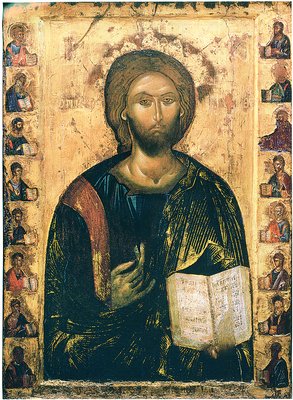
Christ Pantocrator with apostles and prophets.
1st half of 14c
Institute of Byzantine Studies, Venice


HOMILY for St Catherine de Ricci OP
Heb 11:32-40; Ps 30; Mark 5:1-20
Today’s saint, Catherine de Ricci, is representative of the mystical tradition of the Dominican Order, and in this respect, her life mirrors that of her namesake, the great 14th-century Dominican saint, Catherine of Siena. Both saints were Italians, and both had a great love for Christ from their youth. At the age of just 14 in the year 1535, St Catherine, born of the noble and wealthy Florentine family of Ricci, entered a Dominican convent in Prato in Italy. Like the former St Catherine, today’s saint had spiritual visions of the Lord, and on Easter Sunday in 1542, she received a ring from Christ as a sign of his mystical union with her. This ring manifested itself as a red circle in her flesh on her ring finger. Like St Catherine of Siena, today’s saint loved to meditate on Christ Crucified, and, because she was united with Christ, she also bore the stigmata, physical wounds of Christ’s Passion on her own body from Easter of 1541.
From 1542 until 1554, St Catherine de Ricci received weekly ecstasies of the Lord’s Passion in which she physically shared in Christ’s suffering. For 12 years, every week, from noon on Thursday until 4pm on Friday, she experienced the Lord’s Passion, sharing in Christ’s emotional and physical anguish. Those who saw St Catherine at the end of these weekly mystical experiences would say: “It looks as if she has just been taken down from the cross” because her own body bore the marks of the wounds of Christ’s crucifixion. She would later also receive the wounds of the crown of thorns, and her shoulder became indented with the weight of the Cross. As you can imagine, such a spectacle aroused much curiosity and disturbance to her community, so she begged the Lord to “deliver” her from these visible signs, so her stigmata became invisible although she bore the pain of them until she died on 2 February 1590.
Like St Catherine of Siena, today’s saint lived at a time of upheaval in the Church, for the 16th-century saw the Protestant fracture of the Church and the Catholic reforms of the Council of Trent. So, too, like her namesake, St Catherine de Ricci was a mystic dedicated to reforming the Church, and she wrote many letters, and saints, popes, and statesmen flocked to her for her prudent advice and counsel. Between 1552 and 1590, St Catherine herself was elected prioress of her community seven times, and she bore the burden of leadership in very turbulent times as a “martyrdom” she said. Her task, she said, was to make peace “in a world where everything is turned upside down”, and perhaps, we, too, can sometimes feel that our world or even, life in the Church, is turbulent and inverted. But St Catherine’s advice to the Dominican Provincial was that, “with patience we can overcome everything”.
Thus, today’s saint was seldom anxious, or much upset by her sufferings. For not only did she share the Lord’s Passion, but she also endured terrible sickness for much of her life. But despite all this, St Catherine was renowned for her joy. As a contemporary of hers said: “This blessed virgin is the source of immense happiness for the good and upright hearts that know her and of great joy in the Lord”. What is the source of such joy? Union with Christ which was manifest in her mystical experiences, so that even in the midst of great suffering, she had peace and joy, and a patient confidence in God’s love and goodness. Hence her great and simple lesson was this: “We must be content with everything it pleases our Creator to ordain”… “One must surrender oneself joyously to God” just as Christ willingly chose to endure the Passion for love of us sinners.
Perhaps these words of St Paul sum up St Catherine’s life, and can help us make sense of her experience and witness: “the fruit of the Spirit is love, joy, peace, patience, kindness, goodness, faithfulness, gentleness, self-control… And those who belong to Christ Jesus have crucified the flesh with its passions and desires” (Gal 6:22-24).